Product Launch Strategy: A Guide for Success

Every item in your product launch strategy carries hidden assumptions about time, capacity, and alignment. Individually, these may seem harmless, but together, they form a fragile web of dependencies. Many product launches fail because the plan doesn’t account for conflicting priorities, bandwidth mismatches, and silos that only show their edges once the wheels are already in motion.
Skylink Studio, a game development company, faced this firsthand. Creative instincts drove their launches until missed timelines and team silos stalled progress. They used Meegle to manage their product delivery model, moving from reactive execution to a repeatable, cross-functional system that connected ideation to delivery.
In this guide, we’ll unpack the operational forces that make or break high-stakes launches—misaligned comms, last-minute pivots, siloed teams. We'll also show how you can use Meegle’s visual workflows and centralized dashboards to lead cross-functional execution without breaking the delivery rhythm.
What is a product launch strategy?
A product launch strategy is a structured plan that outlines how a company will introduce a new product to the market, ensuring it reaches the right audience, with the right message, at the right time.
It involves coordinating cross-functional efforts across product, marketing, sales, customer support, and operations to align objectives, define success metrics, and manage project execution timelines.
Product management is the strategic function of guiding a product through its lifecycle, from idea to launch and beyond, by balancing customer needs, business goals, and technical feasibility.
Read more about product management here.
Components of product launch
A successful product launch typically involves several key elements that work together to bring a product to market effectively:
 (Source: Freepix)
(Source: Freepix)Pre-launch planning
- Market research and validation - Understanding target audience needs, competitive landscape, and market demand through surveys, focus groups, and testing.
- Product development and testing - Finalizing the product features, conducting quality assurance, beta testing, and addressing any issues before launch.
- Go-to-market strategy - Defining positioning, pricing strategy, distribution channels, and key messaging that differentiates the product.
Marketing and promotion
- Brand and messaging development - Creating compelling value propositions, brand identity, and consistent messaging across all channels.
- Marketing campaign planning - Developing integrated campaigns across digital, traditional, and social media platforms with clear timelines and budgets.
- Content creation - Producing launch materials including websites, demos, case studies, press releases, and social media content.
Operations and logistics
- Supply chain and inventory management - Ensuring adequate product availability, managing manufacturing, and coordinating distribution logistics.
- Sales enablement - Training sales teams, creating sales materials, establishing pricing structures, and setting up customer support processes.
- Technology infrastructure - Implementing necessary systems for order processing, customer management, and analytics tracking.
Launch execution
- Timing and coordination - Orchestrating the launch sequence across all teams and channels with clear milestones and responsibilities.
- Customer acquisition - Executing marketing campaigns, managing early customer onboarding, and gathering initial feedback.
- Performance monitoring - Tracking key metrics like sales, customer feedback, market penetration, and competitive response to adjust strategies as needed.
The success of a product launch depends on how well these components are integrated and executed as a cohesive strategy rather than isolated activities.
Benefits of a product launch strategy
A well-executed product launch strategy delivers significant benefits across multiple areas of business performance:
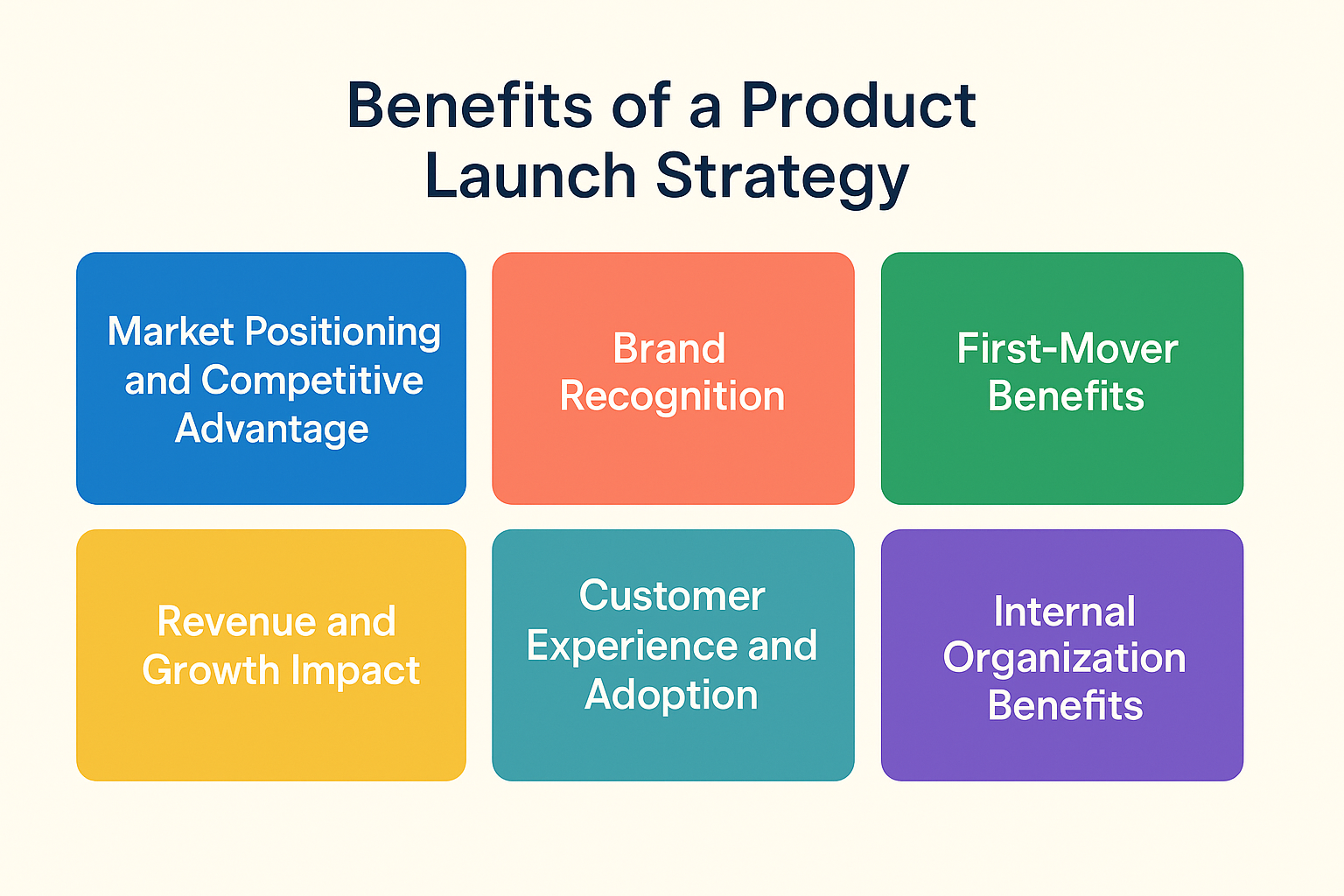 Importance of product launch strategy
Importance of product launch strategyMarket positioning and competitive advantage
- Strong market entry - A strategic launch helps establish your product's position in the market and creates differentiation from competitors from day one.
- Brand recognition - Coordinated launch efforts build awareness and credibility, making it easier for customers to discover and trust your product.
- First-mover benefits - Strategic timing can help capture market share before competitors respond, especially in emerging market segments.
Revenue and growth impact
- Faster revenue generation - Organized launch activities accelerate customer acquisition and sales velocity compared to ad-hoc market entry.
- Higher conversion rates - Well-planned messaging and customer education lead to better qualified leads and improved sales conversion.
- Predictable growth patterns - Strategic launches provide better forecasting capabilities and help set realistic revenue expectations.
Customer experience and adoption
- Smooth customer onboarding - Proper launch preparation ensures customers have positive initial experiences, reducing churn and support issues.
- Clear value communication - Strategic messaging helps customers quickly understand benefits, leading to faster adoption and higher satisfaction.
- Community building - Launch activities can create early adopter communities that provide valuable feedback and become brand advocates.
Internal organization benefits
- Team alignment - Launch strategies coordinate efforts across marketing, sales, product, and support teams toward common goals.
- Resource optimization - Strategic planning prevents wasted effort and ensures marketing budgets are used effectively across channels.
- Learning and iteration - Structured launches provide clear metrics and feedback loops for improving future product releases.
Risk mitigation
- Reduced launch failures - Strategic planning identifies potential issues early and creates contingency plans for common problems.
- Market validation - Pre-launch activities help validate product-market fit before significant investment in scaling.
- Controlled market entry - Phased launch approaches allow for adjustments based on early market feedback without major losses.
These benefits compound over time, as successful launch strategies create momentum that supports long-term product success and market growth.
Product launch strategy phases
A product launch strategy has three main phases:
 Three phases of product launch strategy
Three phases of product launch strategy- Pre-launch: In pre-launch, teams align on goals, validate the market, finalize the product, prepare marketing assets, and ensure internal readiness, so everyone knows what to do when the product goes live.
- Launch: The product goes live, announcements roll out, teams monitor performance, and respond quickly to feedback or issues to ensure a smooth rollout.
- Post-launch: Teams evaluate performance, gather user feedback, fix bugs, and optimize onboarding, messaging, or features to improve adoption and long-term success.
However, instead of thinking in phases, approach launch strategy as layers of defense. An effective launch strategy works across three critical layers, each designed to preempt failure before it escalates:
- Internal readiness: Are teams merely informed, or are they operationally ready? Messaging locked, demos live, enablement materials delivered. Misalignment here delays everything.
- External traction: Can the right users find value fast? Onboarding must handle edge cases and convert initial interest into active product use.
- Post-launch adaptability: Is feedback actionable and routed fast? When signals shift, can you adjust priorities before the impact starts showing up at your churn rate?
TL;DR
- Product launches often struggle due to unclear priorities, team silos, and capacity gaps. Skylink Studio improved execution by using Meegle to connect planning to delivery across teams.
- A strong product launch strategy acts as a layered system of checks. It focuses on internal readiness, user engagement, and quick response to feedback.
- Clear alignment, early validation, and responsive post-launch actions are key to long-term success.
How to build a high-impact product launch strategy: step-by-step guide
Most go-to-market plans focus on the moment of launch, but impact is built on unseen groundwork long before and the orchestration long after.
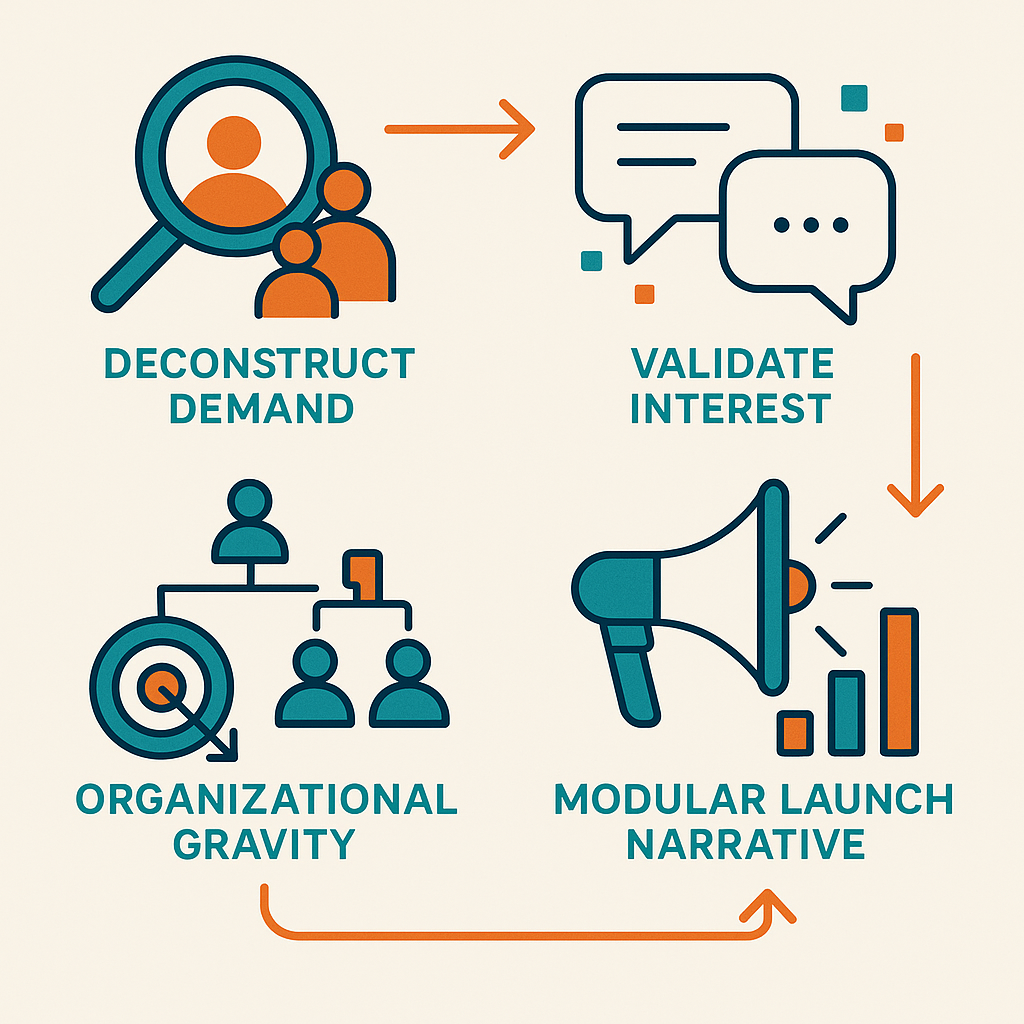 Building a high-impact product launch strategy
Building a high-impact product launch strategySteps to take to build a solid product launch strategy include:
Step 1: Pre-launch preparation
Deconstructing demand before you build hype
Before even considering messaging campaigns or launch tactics, high-performing teams validate whether demand is real and, more importantly, whether it's ready.
Doing this minimizes launch risk by aligning your narrative with actual user demand.
Here’s how to operationalize it:
- Backchannel validation: Create informal signal loops with those closest to real usage
- Customer success managers hear repeated requests
- Beta testers are giving unsolicited feedback
- Sales reps report, “They almost bought—if we had X”
- Beta testers are giving unsolicited feedback
- Customer success managers hear repeated requests
These whisper channels will surface patterns far earlier than NPS scores or post-launch analytics ever will.
- Signal amplification: You already have clues. Dig into:
- Internal usage by customer-facing teams (Are they adopting it? Selling it?)
- Waitlist opt-ins with strong CTA conversion
- Heatmaps and bounce rates on your pricing or features pages
- Sales deck engagement (What’s being skipped? What’s being screenshotted?)
- Narrative stress testing: Before launch day, ask if someone outside the product team, say, a CSM or SDR, can explain the value in 15 seconds without needing a slide deck. Test this internally by:
- Running pitch sessions with role-based scenarios
- Observing new hire onboarding to catch weak messaging points
- Asking Support to write a macro and noting anticipated questions
- Observing new hire onboarding to catch weak messaging points
- Running pitch sessions with role-based scenarios
- Heatmaps and bounce rates on your pricing or features pages
- Waitlist opt-ins with strong CTA conversion
- Internal usage by customer-facing teams (Are they adopting it? Selling it?)
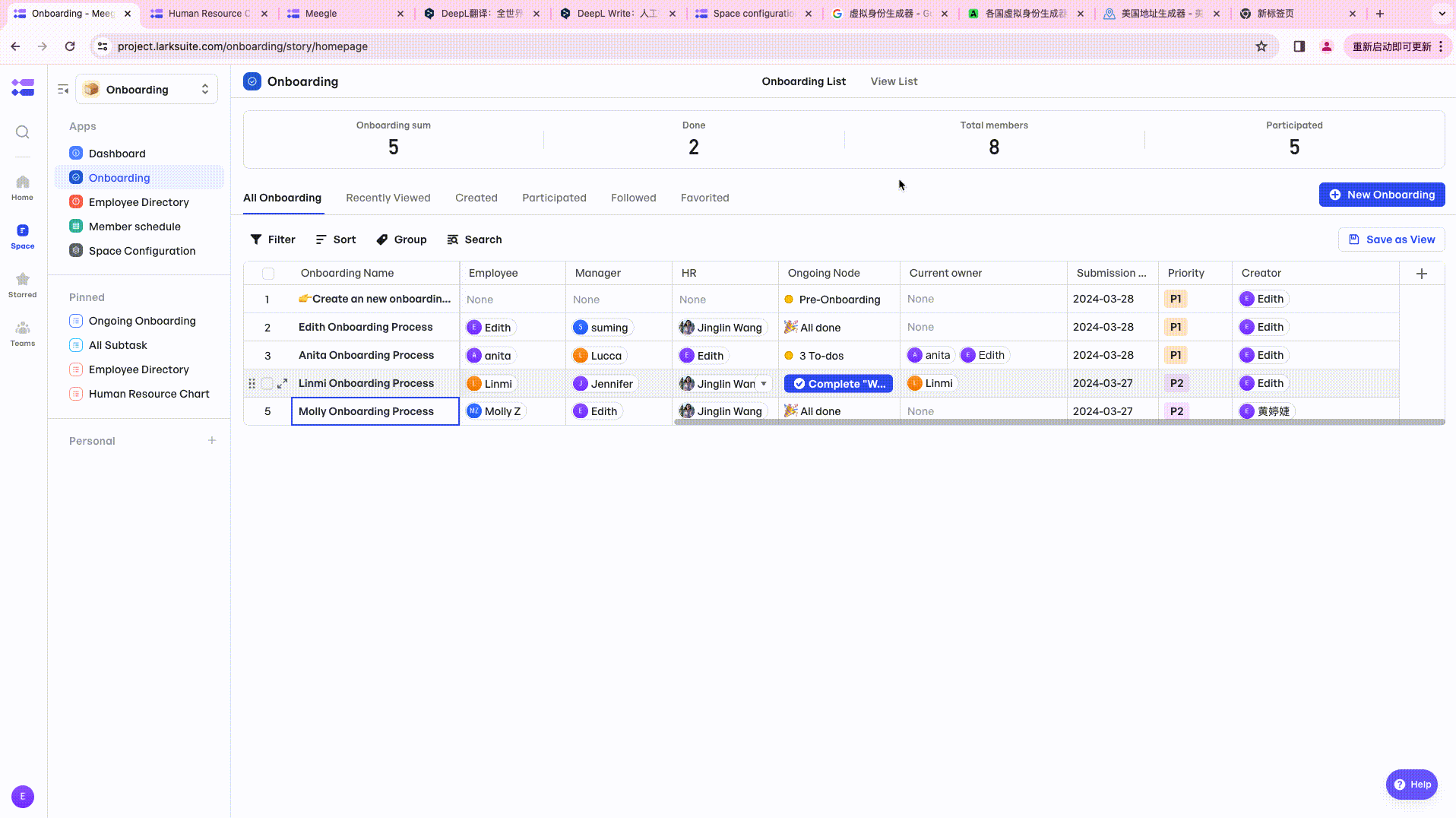 Onboarding new hire through Meegle's onboarding template
Onboarding new hire through Meegle's onboarding templatePro tip: You can also use tools like Meegle that allow you to map messaging clarity across teams to validate if Sales, Marketing, and CX interpret value props the same way.
Engineering pre-launch friction to expose failure points
Sometimes, "smooth launches" are often deceptive and hide issues that only show up when it’s too late. By adding intentional friction before you go live, you force weak spots to reveal themselves under pressure, not under your customers.
To do this, you can:
- Run GTM dry runs with mock users to see if they can find the value prop without internal context
- Put sales through demo drills to check if the narratives are sticking or defaulting to vague pitches
- Enable “shadow features” in production with restricted access to test visibility, click paths, and onboarding flows
- Pressure-test support and customer success on how quickly they can resolve the top five likely questions
Pro-tip: With Meegle, teams can link these dry-run outcomes directly to backlog items, sprint planning tasks, or follow-up actions, ensuring that feedback from friction flows straight into execution without getting lost in side-channels.
Step 2: Stakeholder coordination (Try designing for organizational gravity)
The real challenge is aligning teams that don’t report to you, don’t move on your timeline, and are often balancing competing priorities. Here’s how to stay ahead of the drag:
- Create a working group with reps from Product, Marketing, Sales, Support, and Legal.
- Build a visibility layer across every critical function from product, marketing, sales, CX, and legal, and define deliverables, ownership, and readiness statuses.
- Run short daily syncs with stakeholders from each function. This creates a real-time control loop around your launch to catch slippages and build urgency without email backlogs or async issues.
Pro tip: PMs can use Meegle’s cross-functional planning boards to track ownership and dependencies across teams.
Step 3: Marketing craft (Using a modular launch narrative that adapts over time)
Don't rely on a single “go live” message. Instead, build a launch arc that moves through distinct phases: Tease → Reveal → Deepen → Reinforce. Each phase should deliver a tailored message to a specific audience. Modularity matters because different stakeholders come online at different times, and your narrative has to meet them where they are, not where you hope they’d be.
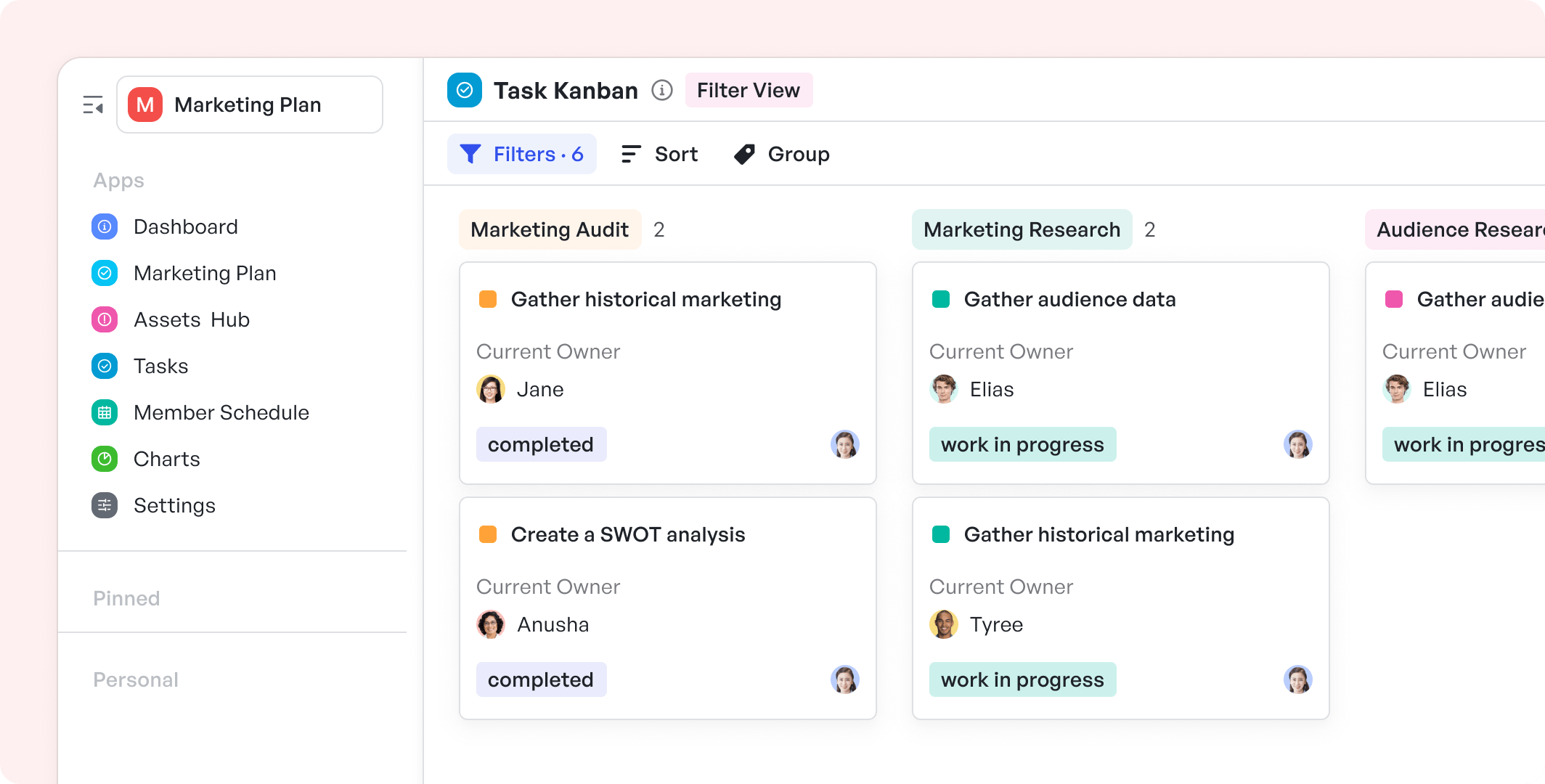 Create a PR plan with Meegle's Marketing Plan Template
Create a PR plan with Meegle's Marketing Plan TemplateCraft a narrative scaffold early that evolves with the product:
- Develop separate narratives for executives, technical users, power users, and prospects.
- Prepare roadmaps, launch emails, in-app tooltips, sales enablement decks, and PR content with timing built around your launch arc.
- Map each message to the appropriate channel (social, email, webinars, sales demos, product blog).
Pro tip: Done right, this layered narrative becomes an internal compass and external amplifier that adapts with the product while keeping every team aligned on what matters most to each audience.
Step 4: Post-launch analysis
Building the post-launch feedback engine before launch
Don’t wait until launch to think about feedback. Build the feedback engine in advance, so you can act fast when real signals roll in. Before you go live, you should already have:
- Clear owners for feedback channels (support, social, CS, community)
- Routing logic for bugs, friction reports, and suggestions
- Dashboards wired to detect adoption drop-offs, activation lags, or sentiment spikes
When feedback has a home from day one, teams can shift from reaction mode to rapid iteration.
Pro tip: Forget vanity dashboards for a bit. Instead, sit with your sales, support, or growth teams and manually track the first 10 user journeys from signup to value.
Watch where they stall, what links they ignore, what emails they open, what CTAs they click, and then reverse-engineer your funnel based on that friction. These raw paths tell you what’s actually happening faster than any high-level metric.
Anchoring launch metrics to business trajectory
It’s easy to celebrate pageviews, social shares, and demo signups as they offer quick feedback and feel good in the moment. But these surface-level signals don’t tell you whether your launch is driving meaningful business impact.
What truly matters are outcome metrics that act as leading indicators that reflect real traction and long-term value:
- Activation milestones - How quickly are new users hitting the first value?
- Expansion signals - Are trial users converting to paid? Are existing customers adopting the new feature?
- Behavioral lift - Is usage frequency increasing in target segments?
By focusing on these signals, teams can prioritize follow-up decisions with greater confidence and alignment around business impact.
How to launch products with Meegle: a comprehensive guide
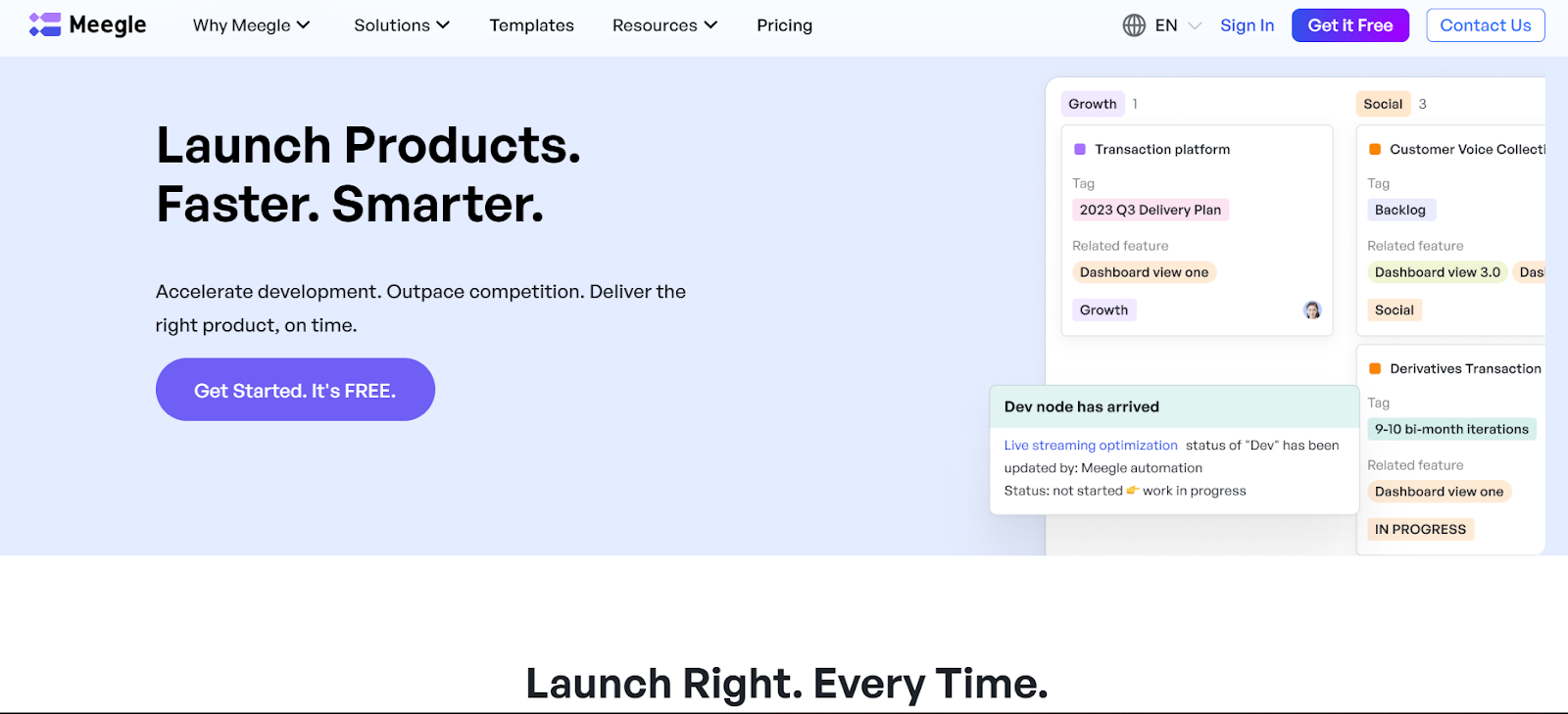 Meegle product management software
Meegle product management softwareLaunching a product successfully requires a clear, repeatable process that keeps teams aligned from planning through execution. What you need is a tool that can bring structure, visibility, and real-time coordination to every phase of your launch journey., and Meegle does that for you. Here's how it helps:
Helping with product discovery using structured experimentation
- Test ideas before you commit: Use Meegle’s hypothesis-driven templates to systematically document assumptions, define measurable success metrics, track outcomes and experiment with project tracking tools forvalidating ideas.
 Hypothesis validation template on Meegle
Hypothesis validation template on Meegle- Track experiments in one connected workflow: Helps PMs document user problems, link them to experiments, and track real-time results, all in a single workflow.
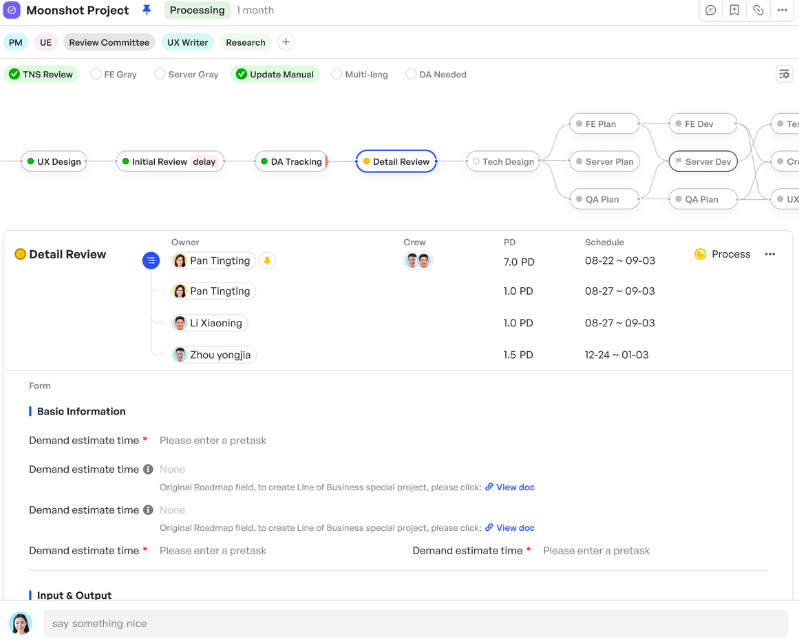 Meegle’s node-driven workflow
Meegle’s node-driven workflowCreating execution-ready roadmaps
Meegle’s also functions as a roadmap software using Work Items let you construct product roadmaps that are dynamic, task-linked plans integrated with Kanban boards, timeline views, and backlog grooming. Every update at the task level reflects instantly on the roadmap.
 Create roadmaps with Meegle’s Work Item feature
Create roadmaps with Meegle’s Work Item featureMeegle also serves as a powerful project timeline tool, enabling product managers to:
- Tailor visibility to every stakeholder: Provides role-based views, so executives see high-level milestones, engineers see sprint tasks, and marketing sees release project timelines, all from the same source of truth, filtered by relevance.
- Keep everyone aligned: Adjust product roadmap timelines and dependencies in real time when priorities change or blockers arise without disrupting visibility or causing version drift across teams.
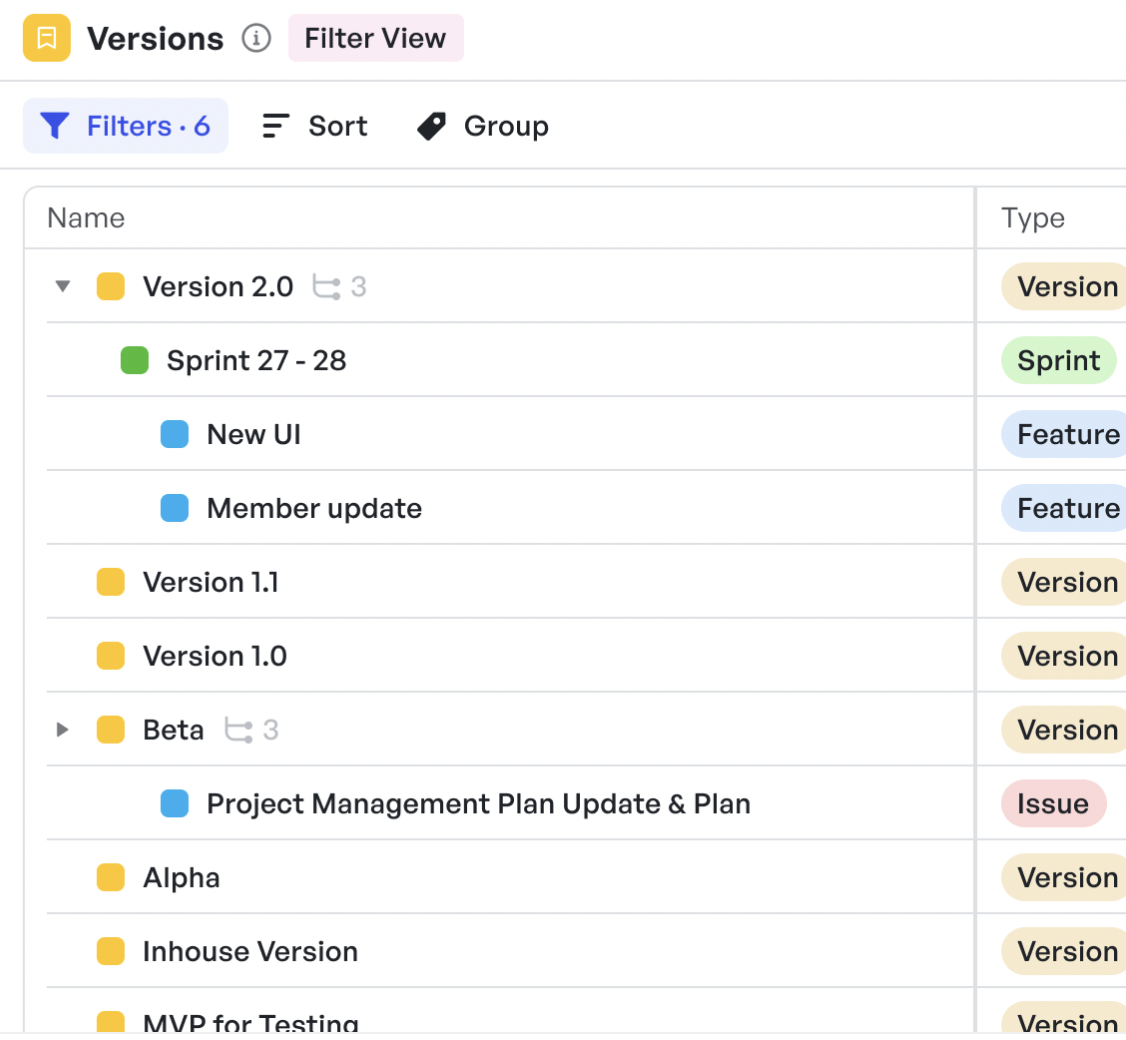 Manage product releases and iterate the product’s roadmap to keep up with shifting priorities
Manage product releases and iterate the product’s roadmap to keep up with shifting prioritiesClosing the feedback loop before and after launch
- Capture feedback at every touchpoint: Centralize insights from surveys, support tickets, and in-app interactions, allowing product teams can link real customer feedback directly to product backlog items, so nothing gets lost between collection and execution.
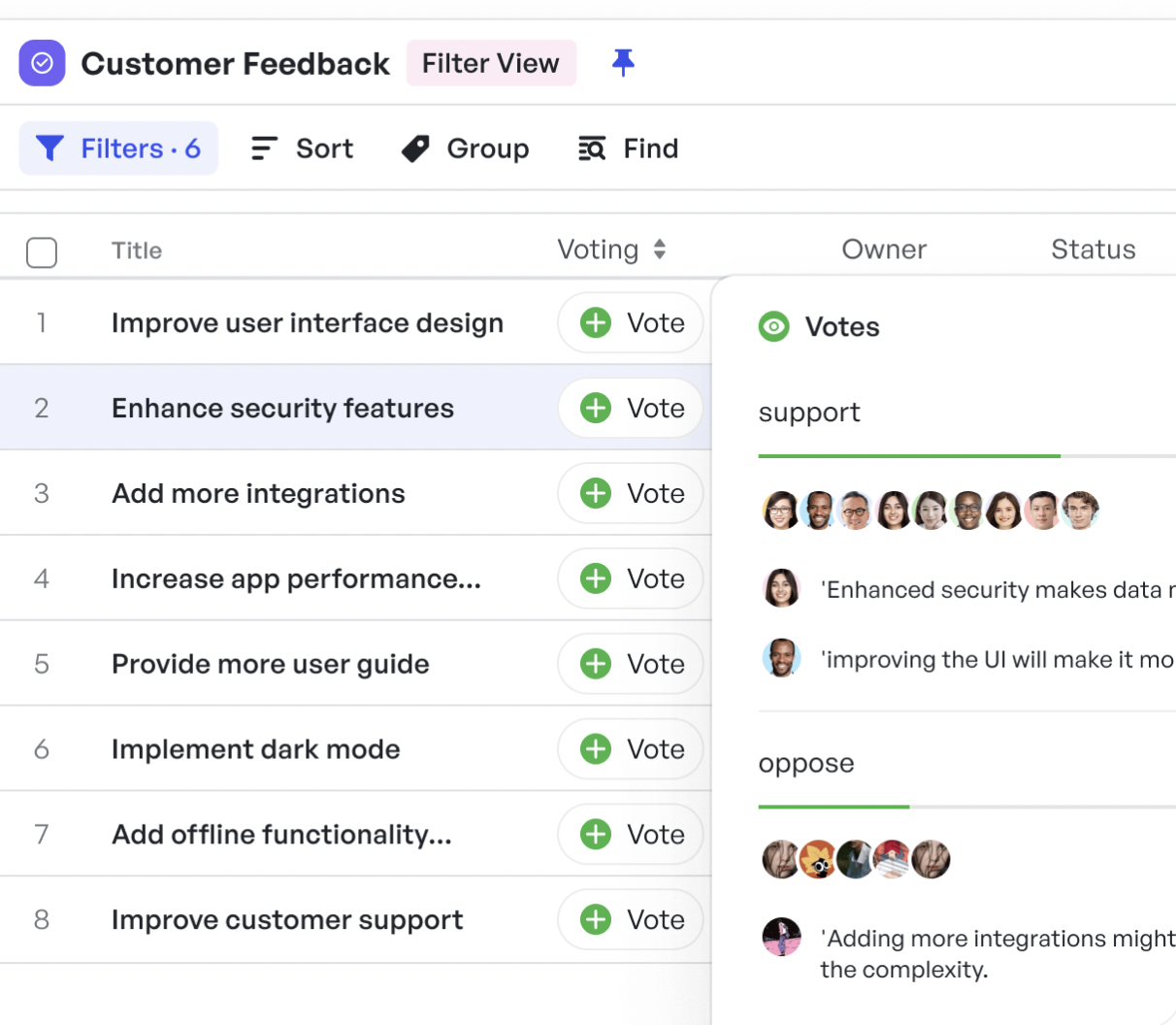 Centralize customer feedback to have a look at the product’s performance
Centralize customer feedback to have a look at the product’s performance- Turn feedback into prioritization signals: Both internal teams and customers can vote and comment on feature requests, helping PMs identify which needs have the most traction across users and teams.
Aligning cross-functional teams better
- Keeps functions aligned without constant check-ins: Meegle structures projects around clearly assigned work items, where each task is linked to broader product management goals, contributors, and expected outcomes.
- Reduces communication gaps with embedded collaboration: Instead of disconnected updates or scattered threads, Meegle keeps discussions, files, and updates within each task, so cross-functional teams stay in sync as work evolves.
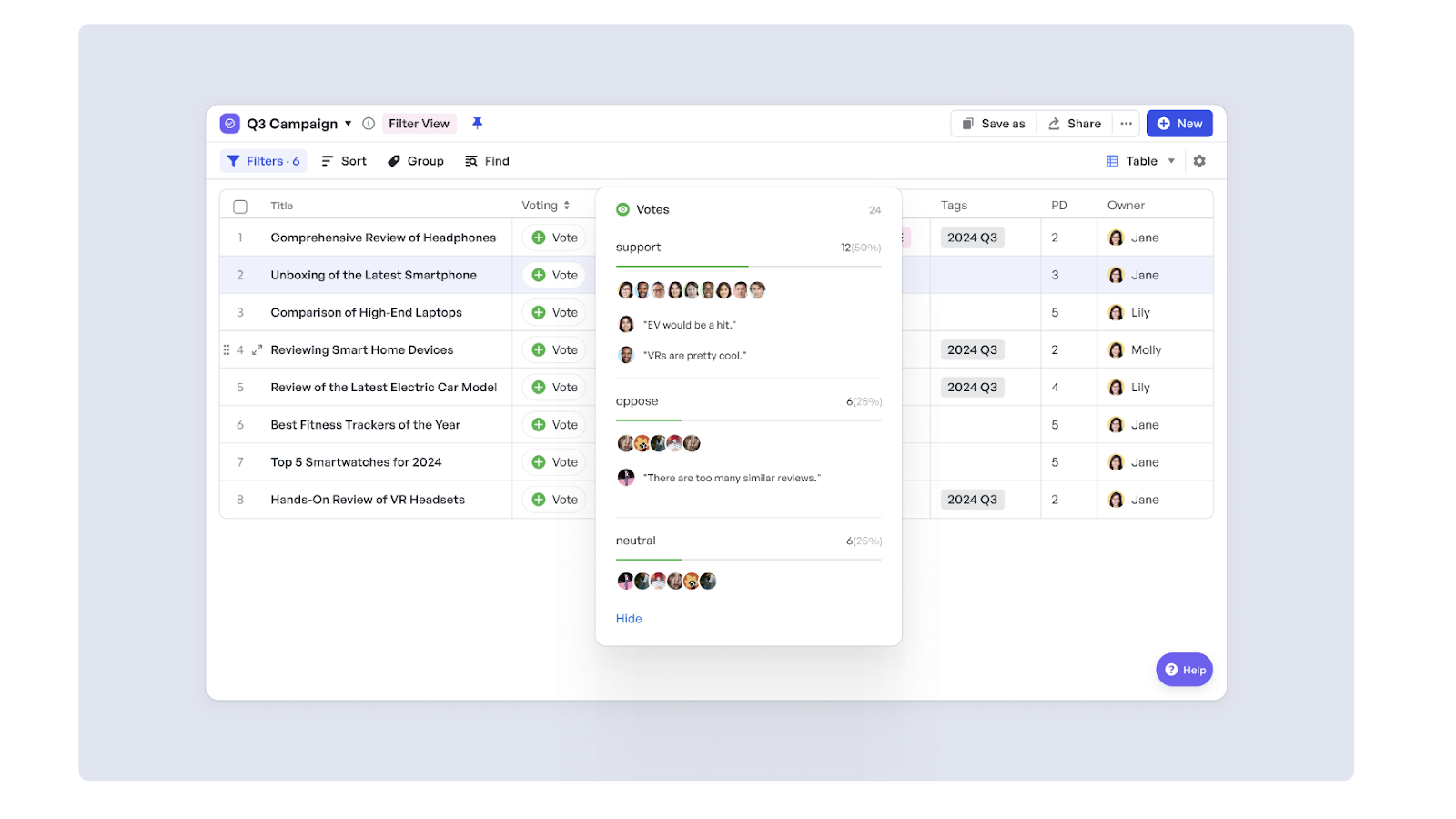 Team members collaborating within projects
Team members collaborating within projectsPlanning with built-in ops intelligence
- Sequence cross-functional work with precision: Map launch-critical tasks, tie them to blockers, assign them across departments, and monitor completion in Gantt, Table, or Kanban views.
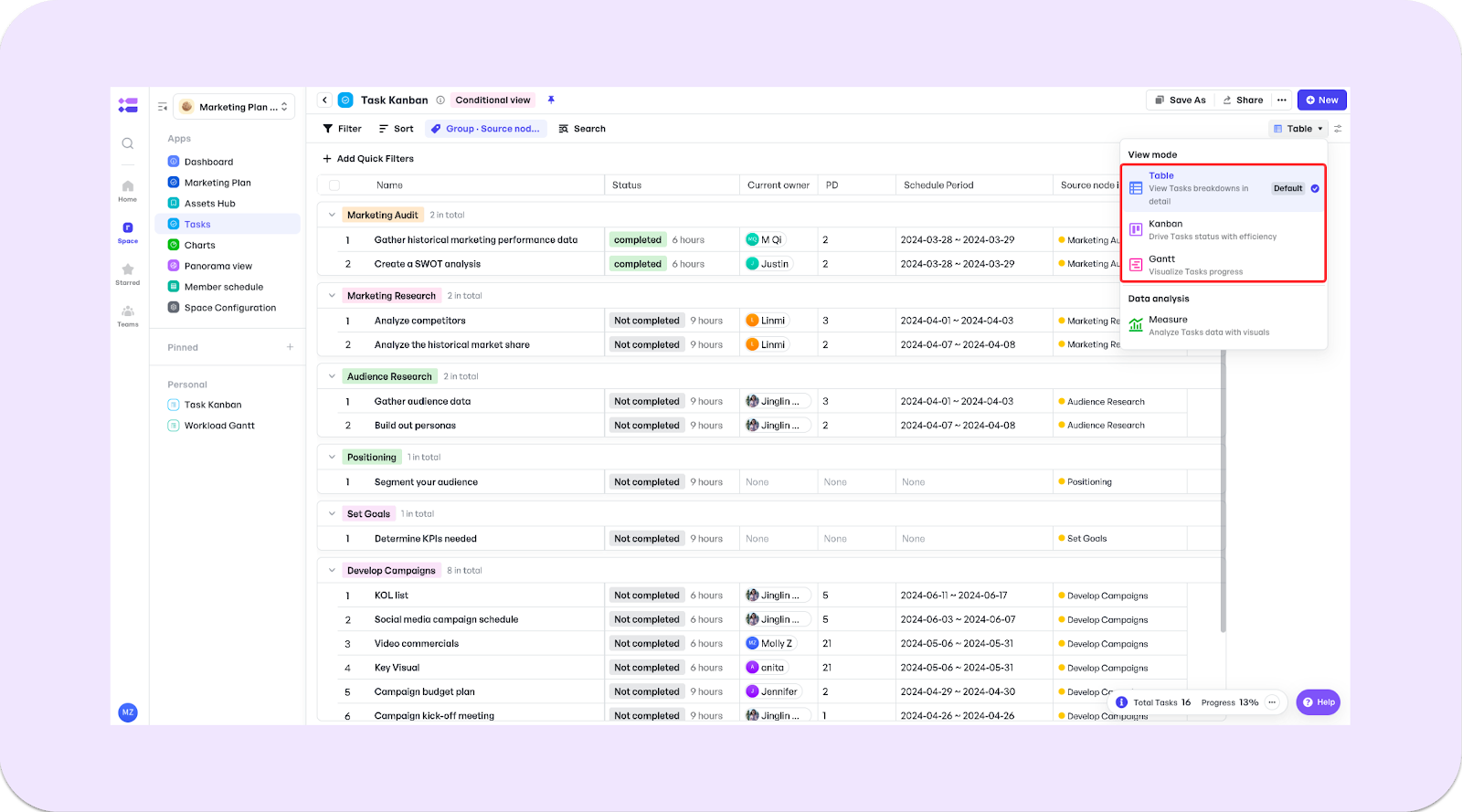 Meegle’s Table View for operational granularity
Meegle’s Table View for operational granularity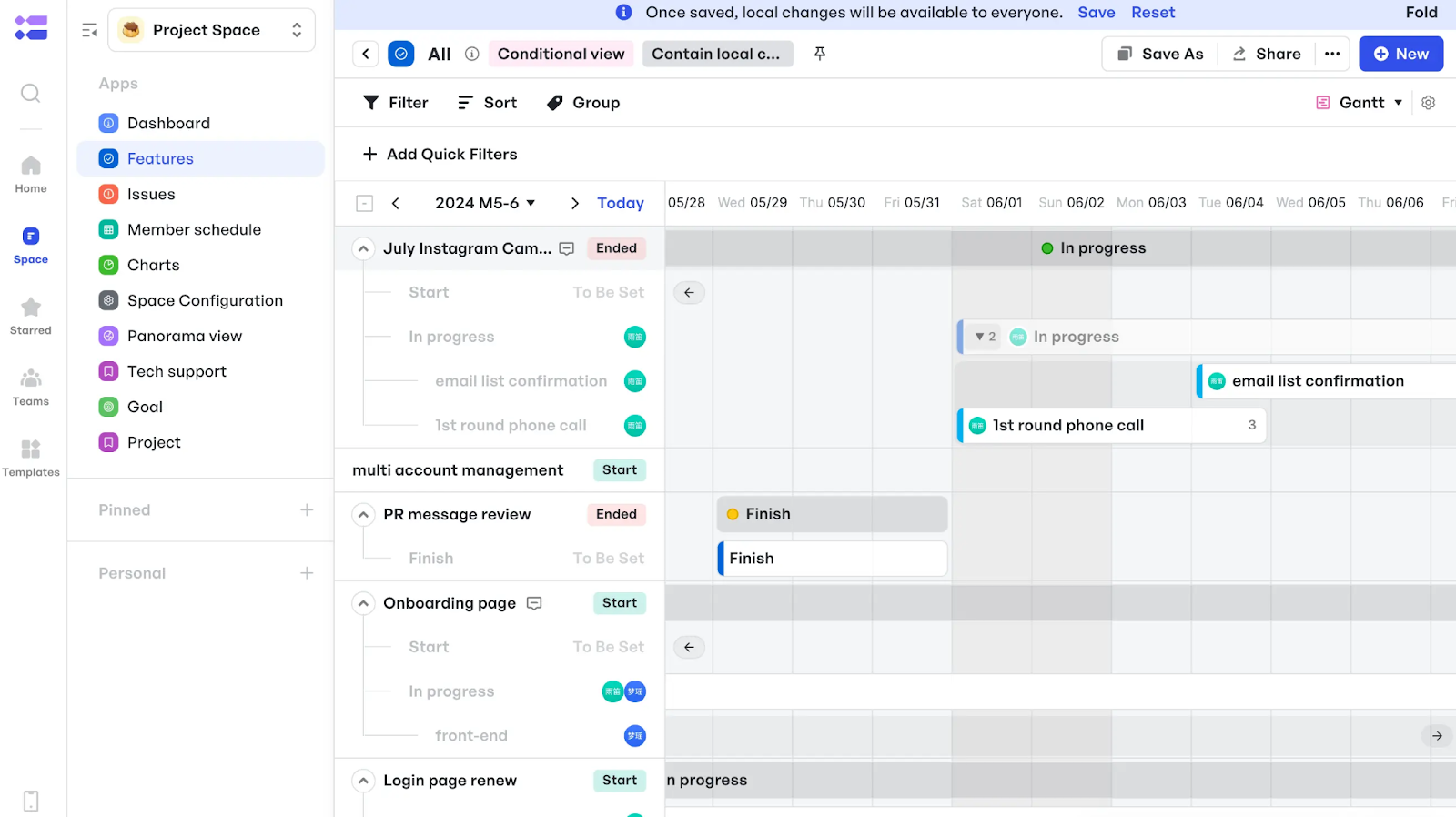 Meegle’s Gantt View for timeline dependencies
Meegle’s Gantt View for timeline dependencies Meegle’s Tree View for the relationship tying dependencies and hierarchy between tasks
Meegle’s Tree View for the relationship tying dependencies and hierarchy between tasks- Connect task-level execution to launch-phase milestones: Track product management processes across pre-release, launch day, and post-launch ops phases with stakeholders looped in via alerts and automated status reports.
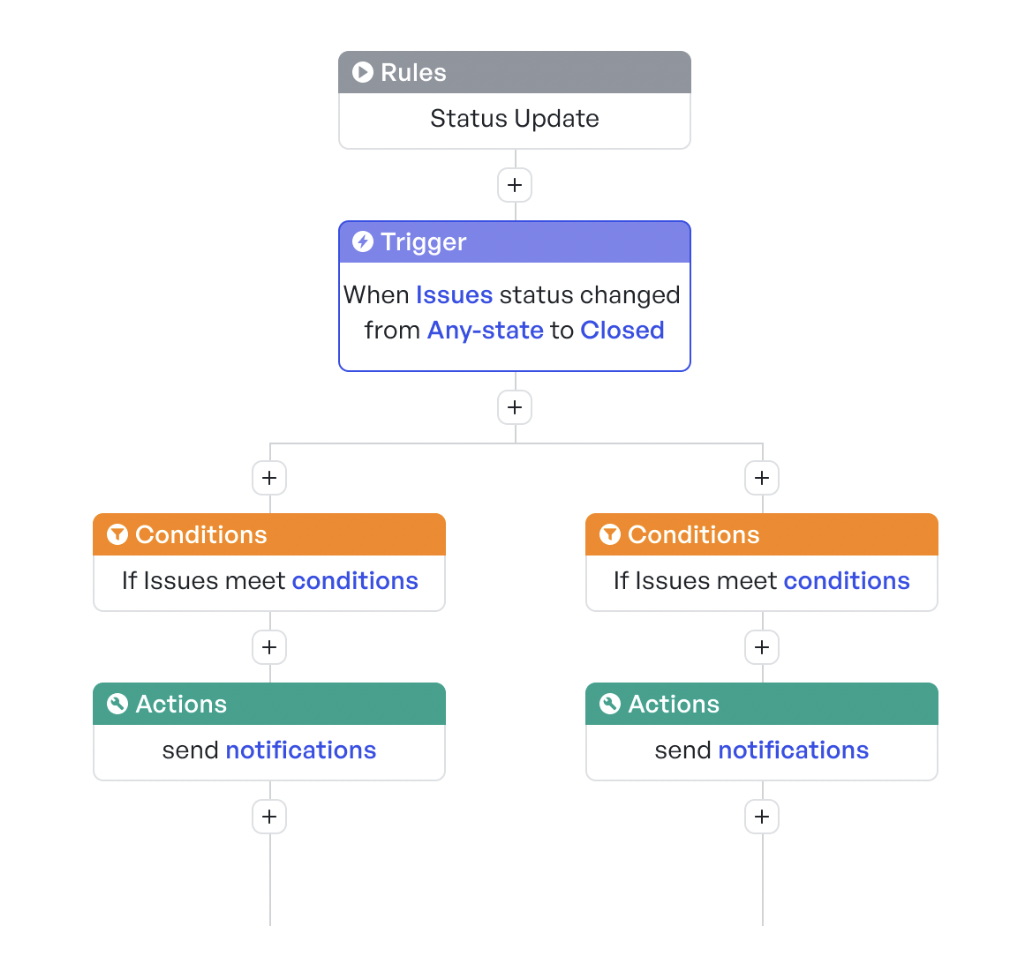 Set specific criteria to create custom automation for status updates
Set specific criteria to create custom automation for status updates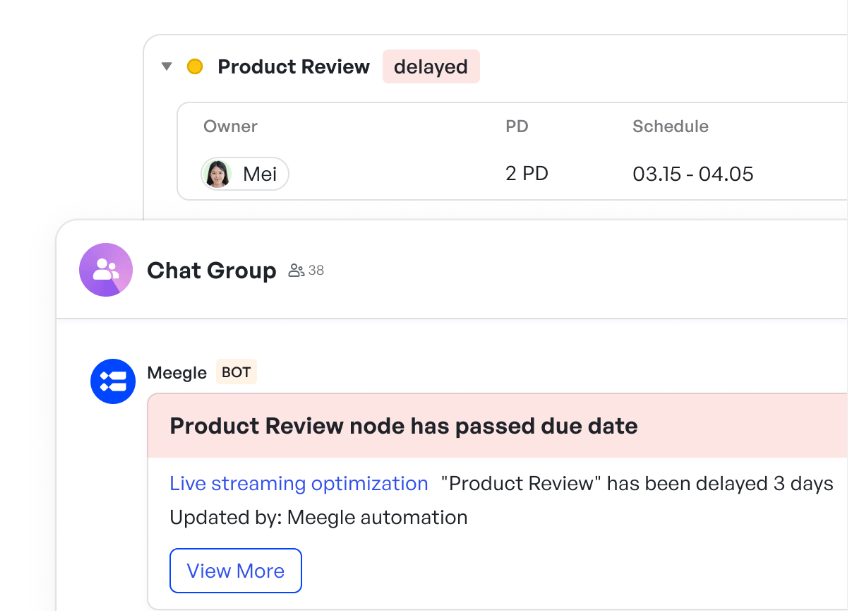 SMART automation reminder on a product review phase
SMART automation reminder on a product review phaseMaking data-driven launch decisions
- Transform metrics into real-time decisions: Track engagement, adoption velocity, and backlog movement across launch phases using reporting charts.
 Meegle dashboard
Meegle dashboard- Tailor analytics to what matters: Use custom formulas and flexible chart types (pie, bar, line) to measure launch effectiveness by team performance, activation rates, or feature adoption, and adjust tactics mid-rollout based on live user behavior.
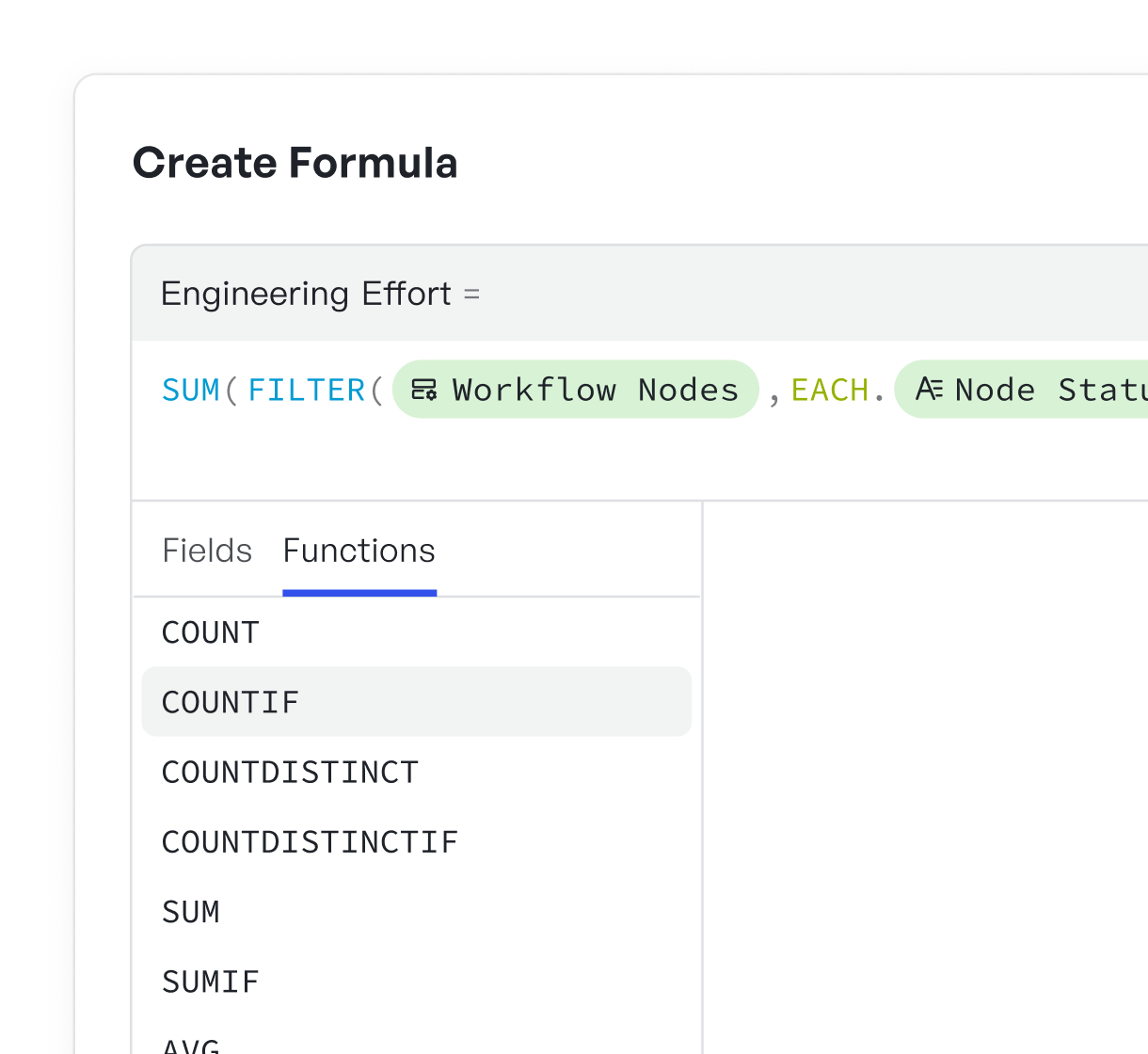 Create a custom formula to analyze chart data
Create a custom formula to analyze chart dataAligning product launch with strategic OKR management
- Turn goals into live and trackable workflows: Connect high-level objectives (like a successful launch or feature adoption milestones) directly to execution layers—tasks, sprints, and releases to ensure every key result is tied to visible, in-progress work.
- Use templates to standardize product development goals: Utilize tested and repeatable structures to define, align, and track goals across every phase of product development. Instead of loosely defined targets or vague priorities, Meegle’s OKR template helps you set ambitious but measurable objectives that focus on outcomes.
Suggested resource: Meegle’s product launch strategy template
What changes when you launch with Meegle?
Each phase of a product launch brings a different kind of friction. Here’s how Meegle fits into the work and not just the plan:
| Product Launch Phase | Product Manager Challenge | Meegle’s Value |
|---|---|---|
| Discovery | Navigating ambiguity, validating ideas | Hypothesis-driven experiments & documentation |
| Planning | Translating strategy into action | Live roadmaps, backlog management, dependency views |
| Coordination | Keeping teams aligned across silos | Role-based views, task clarity, shared workflows |
| Execution | Hitting timelines with no last-minute surprises | Cross-functional readiness tracking & milestone mapping |
| Post-launch | Acting on feedback, measuring impact | Feedback loops, analytics dashboards, and sprint retros |
Mistakes to avoid when creating product launch strategies
Every product launch offers a powerful opportunity to grow and often, the most valuable insights come from the missteps we manage to sidestep. While some mistakes can be course-corrected in hindsight, the real advantage lies in anticipating them before they happen.
Some common pitfalls that can arise at various stages of a product launch include:
Product pre-launch mistakes
- Mistaking stakeholder consensus for market readiness: Google Allo had internal buy-in and PR buzz, but it launched into a saturated space already dominated by WhatsApp and Messenger. The product didn’t fail because it wasn’t polished, but because its demand was never pressure-tested.
You can avoid this mistake by:
- Validating early and quietly with whisper channels via beta testers, CSM conversations, and sales objection data.
- Look for pull, not just readiness. You can get info for high-intent behavior through waitlist signups, pricing page traffic, or repeat demo requests.
- Underestimating resistance to brand positioning changes: PMs often refine the narrative late, after field teams have already locked in enablement decks or updated their script.
You can avoid this mistake by:
- Freeze messaging at least one sprint before launch and communicate changes across all functions at once.
- Use workflow tools (like Meegle) to assign messaging updates as live work items with due dates, reviewers, and approvals.
Product launch-day mistakes
- Treating launch as a “day” instead of a campaign: Too many teams treat launch like a deadline, not a system. There’s no narrative sequencing, no follow-up engagement, and no planned momentum.
You can avoid this mistake by treating each stage on launch day as a separate micro-campaign, not a one-and-done push.
- Letting marketing lead the launch without product accountability: When marketing owns the launch alone, the outcome often skews toward show over substance. The story becomes inflated, the assets drift from what is shipping, and no one’s on the hook for continuity after launch week.
You can avoid this by assigning a launch PM or cross-functional lead who co-owns success with marketing, ideally someone who understands both narrative and capability constraints.
Post-launch mistakes
- Failing to close the loop on early adopters: Organizations often over-leverage early adopters during beta and pre-launch stages but fail to maintain structured engagement after release. These users represent the most informed and invested customer segment and yet, post-launch processes frequently exclude them from the communication loop.
You can avoid this by:
- Establishing a formal post-launch engagement protocol for beta and early users, including follow-up outreach within 7–10 days and periodic roadmap updates.
- Assigning accountability for tracking early adopter feedback in the same system used for sprint planning (e.g., linked as tagged feedback in Meegle or CRM).
- Routing actionable feedback to delivery teams via structured workflows with clearly defined SLAs for response and resolution.
- Measuring output and ignoring traction: In our podcast on mastering product-led growth, Todd Birzer had this to say:
"Metrics like activated sign-ups and product-qualified leads align teams toward shared goals. These aren’t vanity metrics; they reflect real user success and help drive scalable growth across the business.”
It is important to assess metrics like traffic, impressions, or initial signups, but you must also go a step further to evaluate whether the product is driving sustained usage or business impact to avoid having an inflated sense of success without meaningful product validation.
You can avoid this by:
- Integrating product analytics directly into post-launch review cycles, focusing not just on the quantity of engagement, but the quality and frequency of behavior across cohorts.
- Tying these KPIs back to business-level objectives (e.g., free-to-paid conversion, expansion in strategic accounts) to evaluate launch performance holistically.
Examples of successful product launches
When it comes to product launches studying what worked can be just as illuminating as understanding what didn’t. Here are some standout examples of product launches that got it right:
1. Skylink Studio: Reorganized processes and priorities
Previously mentioned as a standout example, Skylink Studio offers a closer look at how rethinking internal systems can drive stronger launches. The game development company had a problem with creating an adaptive system that could bridge ideation, execution, and product delivery, especially across multiple teams and timelines.
They reassessed their launch pipeline and restructured the entire product delivery model around Meegle.
Instead of treating game launches as creative sprints fueled by instinct, Skylink Studio operationalized the process:
- Strategic decomposition: Using Meegle’s tree-view, product managers were able to layer high-level roadmaps down to feature-level granularity. Every asset, release version, sprint cycle, and backlog item had a place and a clear downstream dependency.
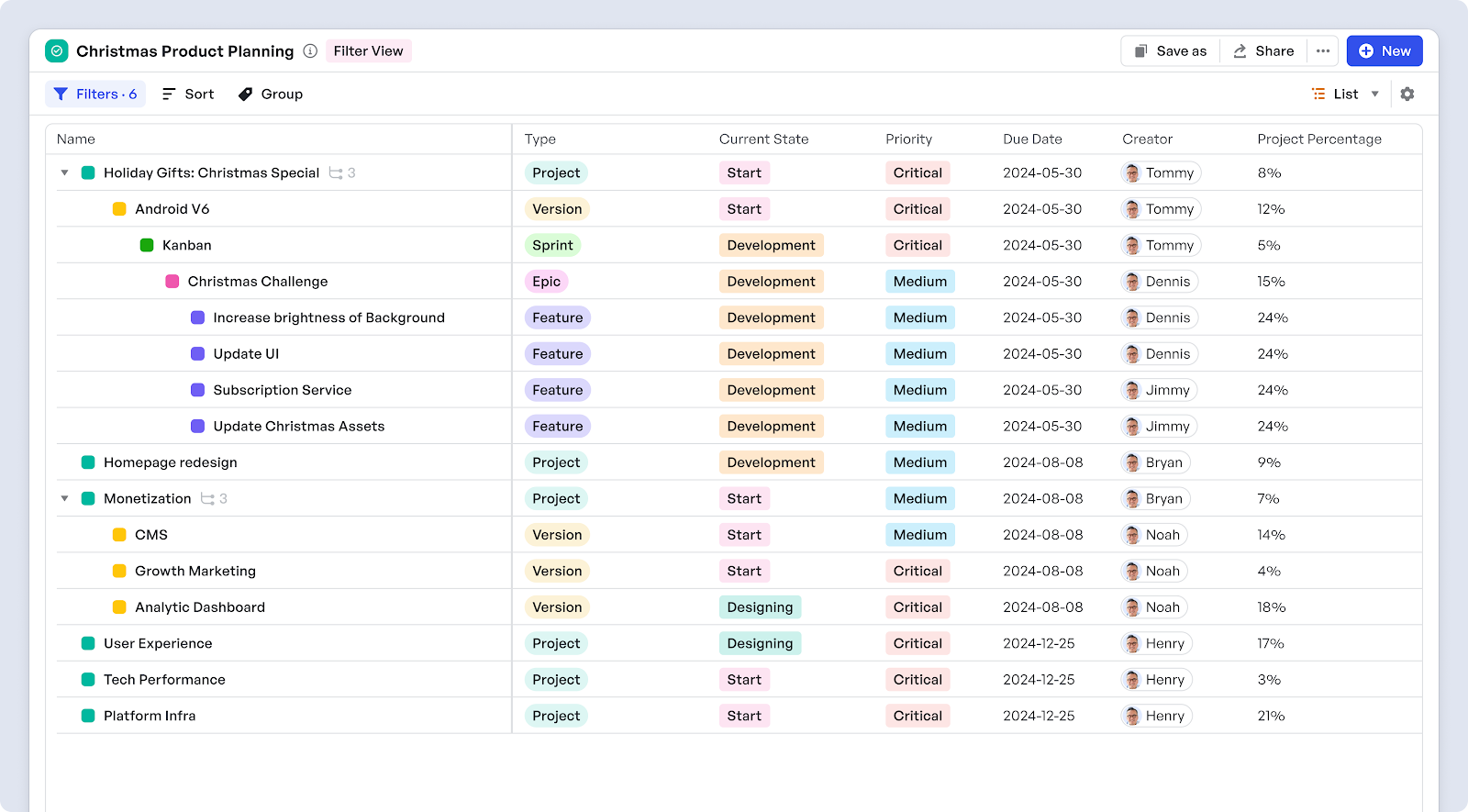 Skylink's product roadmap with Meegle's Tree View
Skylink's product roadmap with Meegle's Tree View- Execution as coordination: Meegle’s visual workflows acted as live execution blueprints, mapping how foundational work like UI prep, asset integration, and QA linked into development cycles and go-to-market actions.
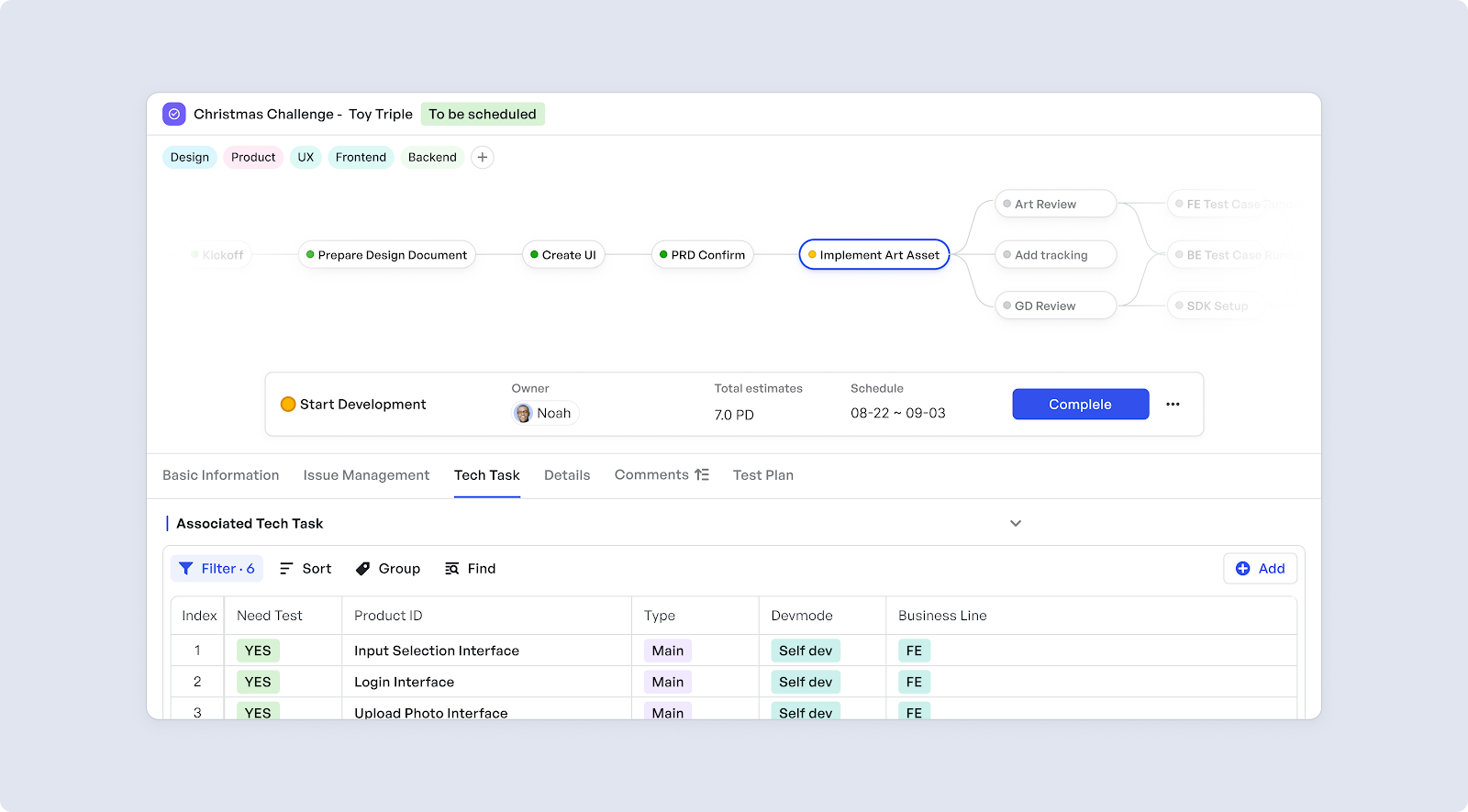 Skylink's visual workflow on Meegle
Skylink's visual workflow on Meegle- Adaptive intelligence: Rather than wait for status meetings, leadership reviewed real-time charts showing implementation velocity. Product owners can track bug closure trends and workload imbalance, giving insight to reallocate resources and make trade-offs proactively.
 Skylink’s project progress overview on Meegle
Skylink’s project progress overview on Meegle Skylink’s bug resolution insights on Meegle
Skylink’s bug resolution insights on Meegle2. Adriel: Targeted early adoption via channel-platform fit
Adriel, a B2B SaaS marketing dashboard, decided to launch where attention already existed.
By using Product Hunt and AppSumo, platforms natively aligned with their ICP (lean marketers, SMB operators, early-stage adopters), they avoided the common trap of wasting launch energy on audiences not primed to care.
Strategic differentiator: Rather than treat these platforms as one-time distribution channels, Adriel used them as validation loops to capture user feedback and turn early users into advocates.
Post-launch, Adriel didn’t pivot to scale. Instead, they doubled down on relationship-building by running local events like the Austin Marketing Summit and engaging marketers via WhatsApp, KakaoTalk, and LinkedIn.
3. Feefo: Controlled redesign rollout with feedback-first activation
Feefo faced a classic high-risk SaaS scenario, which was redesigning a core interface used by existing customers daily. A UI overhaul without preparation almost always results in user frustration and productivity dips, so they decided to treat the redesign as a launch, not a technical release.
Strategic differentiator:
They used proactive UX messaging through Appcues and early-access opt-ins to de-risk the shock of change. Rather than flip the UI overnight, they layered their rollout in three stages:
- Teasers to seed awareness
- Pre-release access to allow users to test the new UI
- Feedback loops before full release to refine based on usage
4. Userpilot: Multi-channel feature launch with live education
Userpilot’s launch of their new analytics feature didn’t just show the feature, it created a narrative arc around why it mattered.
The launch was structured around community engagement, real-time education, and open access, with each reinforcing the feature’s strategic value.
Strategic differentiator: Instead of relying solely on Product Hunt visibility, they pre-seeded interest via email and directed users into a high-signal event: a live product webinar hosted by leadership and product leads.
Product launch checklist
Use this checklist to make sure nothing critical slips through the cracks as you move from concept to customer.
Pre-Launch
- Define high-intent segments with behavioral traits.
- Benchmark competitor launch velocity, GTM positioning, and pricing elasticity.
- Stress-test your value proposition with sales and CS before finalizing messaging.
- Align pricing with onboarding effort and expected time-to-value.
- Map marketing channels to funnel stages (awareness, activation, retention).
- Create a scenario-based GTM playbook (Plan A, B, and fallback).
- Write internal comms playbooks by function.
- Track and tie product KPIs to product-stage maturity: e.g., activation rate > signups.
- Pre-approve all creative assets for versioning by platform.
- Stage media/PR drops based on newsworthiness tiers, not just timelines.
- Run cross-device, multi-role QA to surface edge-case bugs.
- Create customer support macros + route complex inquiries to SMEs.
Launch day
- Run a go-live checklist dry run 24 hours before the real thing.
- Route inbound leads through tiered sales follow-up playbooks.
- Sequence marketing activation across platforms by peak engagement windows.
- Designate one owner for real-time monitoring per function (e.g., web, CX, social).
- Capture qualitative feedback via live tags.
- Establish a launch-day command center for cross-functional coordination.
- Push hotfixes via a pre-cleared release lane if issues emerge.
- Track leading behavior metrics (e.g., first action taken) before topline numbers.
Post-launch
- Deploy contextual NPS or CES tied to in-app behaviors.
- Run a structured post-mortem focused on what scaled, what stalled, and why.
- Analyze retention by acquisition source to assess funnel efficiency.
- Classify user feedback by urgency and feasibility to prioritize fixes.
- Review media reach vs. engagement to optimize future narrative hooks.
- Identify emerging user champions for future testimonial or case study work.
- Launch sprint #0 for follow-ups: immediate iteration, not new features
- Archive all comms, campaign assets, and feedback for future reuse.
By combining these structured steps with Meegle’s robust project management capabilities, you can transform your product launch into a repeatable, scalable process that drives long-term success.
Stay on top of every task, team, and timeline—plan your launch with Meegle today.
FAQs
What are the 7 steps of product launch?
- Market research – Validate demand, segment your audience, and benchmark competitors.
- Product positioning – Define your value proposition and core messaging.
- Go-to-market planning – Select launch channels, timing, and promotional tactics.
- Cross-functional alignment – Ensure sales, marketing, support, and engineering are fully briefed and resourced.
- Asset creation – Build content, campaigns, demos, and onboarding materials.
- Launch execution – Activate campaigns, monitor feedback, and coordinate team actions.
- Post-launch analysis – Measure performance, assess adoption, and plan iterations.
What are the 4 Ps of product launch?
These refer to the marketing pillars that support any launch strategy:
- Product – What you're launching, including key features and differentiation.
- Price – Your pricing model and packaging strategy are aligned with perceived value.
- Place – The distribution and delivery channels used to reach your target audience (e.g., App Store, enterprise onboarding, direct sales)
- Promotion – The campaigns, messaging, and tactics used to drive awareness and activation.
What are the 7 steps to develop a product strategy?
A strategic product roadmap typically emerges from these core activities:
- Identify market opportunity – Validate a real user need or market gap.
- Define the target user – Build detailed personas based on behavior and use context.
- Set strategic objectives – Tie product goals directly to business outcomes.
- Analyze competition – Understand positioning gaps and threats.
- Map key differentiators – Determine how your product uniquely delivers value.
- Plan the delivery approach – Define MVP scope, launch milestones, and resourcing needs.
- Establish metrics and success criteria – Decide how you’ll measure impact and adjust post-launch.
What are the five steps to launching a product?
- Plan the narrative – Position the product clearly for both internal teams and external users.
- Enable the org – Ensure marketing, sales, and support have what they need to execute.
- Activate the market – Launch targeted campaigns to drive awareness and onboarding.
- Monitor and support – Track user behavior, fix friction fast, and respond in real time.
- Review and optimize – Use feedback and data to evolve both product and GTM strategy.
The world’s #1 visualized project management tool
Powered by the next gen visual workflow engineRead More
Check All BlogsStart creating impactful work today



